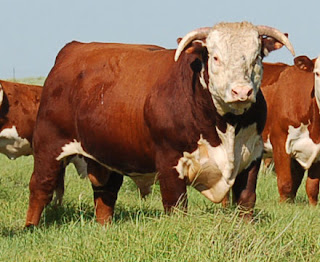Polled Hereford is a cattle breed without horns. As its name indicates, it is polled. It was first bred in the USA by many Hereford breeders. The breeders found hornless (polled) cattle beneficial, so they bred this breed to major benefits. In the year 1970, the number of polled Hereford cattle was enough to register. In 1920, this breed was first introduced to Australia. A total of three cows and three bulls were imported to Queensland. Gradually this breed reached the southern states. In 1922, the first breed association was formed. In the following year 1933, Australian Poll Hereford Society was established.
There are multiple benefits of polled Hereford cattle. For these benefits, this breed was specially bred. The main advantage of having no horns is saving time. No time and money are required to dehorn cattle. Polled Hereford cattle save time, labor, and money spent on dehorning them. The chosen method of dehorning has varying costs. Dehorning also causes stress to the calves, so polled Hereford reduces this stress. On the farm, cattle with horns cannot be kept. It may prove dangerous for them.

Polled Hereford Pros
There are multiple benefits of polled Hereford cattle. For these benefits, this breed was specially bred. The main advantage of having no horns is saving time. No time and money are required to dehorn cattle. Polled Hereford cattle save time, labor, and money spent on dehorning them. The chosen method of dehorning has varying costs. Dehorning also causes stress to the calves, so polled Hereford reduces this stress. On the farm, cattle with horns cannot be kept. It may prove dangerous for them.

Polled Hereford cattle cannot harm anyone with their horns. So having no horn makes them valuable. The hornless cattle are sold at a very high price. Its milk is also sold at a high cost. An animal that is naturally polled can be achieved within one generation. When one polled and one-horned cattle are bred together, the resultant animal will be polled. The development and production of polled cattle are fast. Three combinations of genes can produce polled Hereford cattle. PP with no horns, Pp may have horns, and pp have horns. The production of polled Hereford cattle is easy and convenient. So from a commercial point of view, polled Hereford is worthy.
To achieve a polled Hereford cattle care is required to select the genetic plan of cattle. Although it is beneficial for the farm still, you need to think twice before selecting polled Hereford cattle for your farm. Polled Hereford is highly demanded, but it should also be considered that keeping polled Hereford is not easy. The maintenance of polled Hereford is problematic because even a minor gene variation can lead to horned Hereford cattle. A heterozygous polled bull does not always produce a 100 percent polled calf. You always have to choose homozygous polled Hereford cattle for breeding to maintain the breed. The availability of polled Hereford is low.
Polled Hereford Cons
To achieve a polled Hereford cattle care is required to select the genetic plan of cattle. Although it is beneficial for the farm still, you need to think twice before selecting polled Hereford cattle for your farm. Polled Hereford is highly demanded, but it should also be considered that keeping polled Hereford is not easy. The maintenance of polled Hereford is problematic because even a minor gene variation can lead to horned Hereford cattle. A heterozygous polled bull does not always produce a 100 percent polled calf. You always have to choose homozygous polled Hereford cattle for breeding to maintain the breed. The availability of polled Hereford is low.
The production of polled Hereford is easy, and it will still take generations to completely overcome horned Hereford cattle. Sometimes, even with high genetic selection, the levels of genetics do not match up. With selective genetic makeup, many other differences have been observed. In heterozygous Hereford cattle breeding, 450 pounds of milk and 47 pounds of fat and protein is suspected with polled individuals. But in the case of homozygous Hereford cattle breeding, almost 1100 pounds of milk and approximately 100 pounds of fats and proteins is sacrificed.










0 Comments